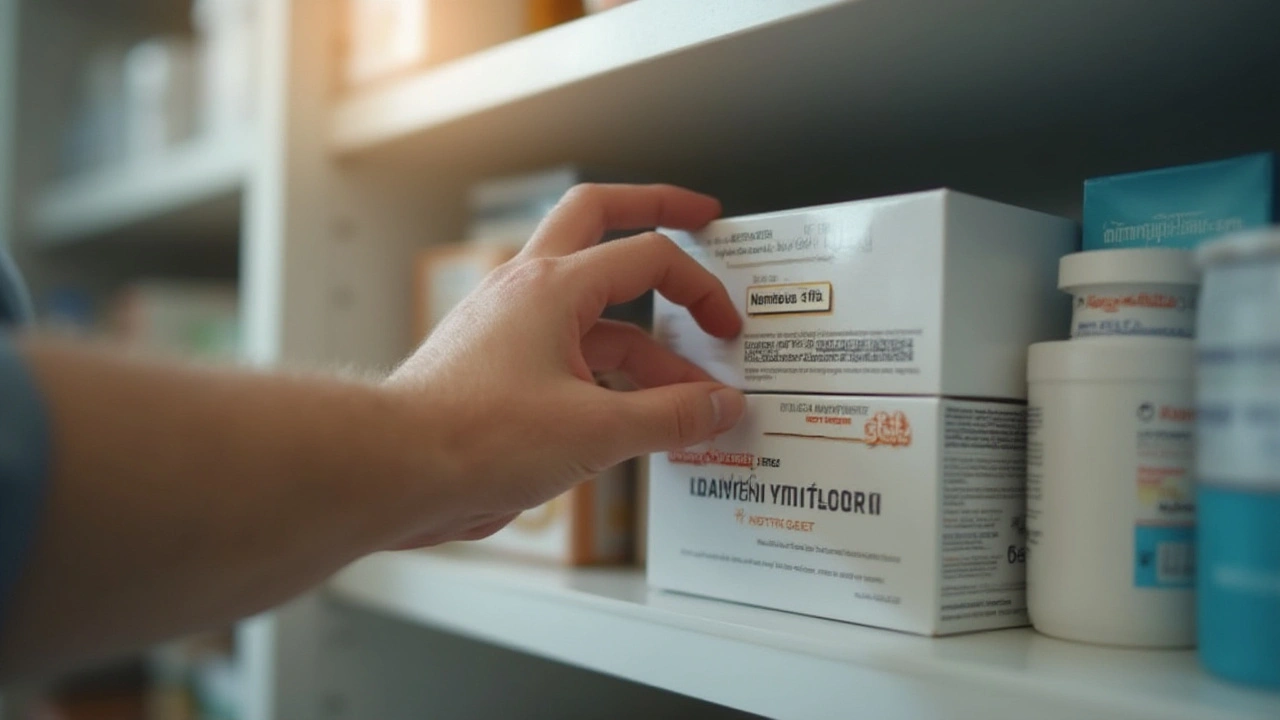For decades, montelukast looked like the golden child of daily asthma control meds. Doctors prescribed it to millions because it didn’t require inhalers, could be swallowed as a pill or chewable, and worked for both kids and adults. Sounds easy, right? But here’s the thing: over the last few years, more and more people have started rethinking this medication. Stories of stubborn side effects, black-box warnings, and newer asthma strategies have pushed many patients and doctors to ask—should we move on?
Why Montelukast Was So Popular
Rewind to when montelukast first hit pharmacies—suddenly those wheezy nights became less common for lots of folks. This pill, belonging to a group called leukotriene receptor antagonists, works by blocking leukotrienes, molecules that cause swelling in your airways. The idea was simple: stop that swelling, stop the attacks. Montelukast also had the advantage of helping those with allergic triggers and stubborn exercise-induced symptoms—it wasn’t just for classic asthma attacks.
One big selling point was convenience. People who didn’t want to use steroid inhalers, worried about the taste or hassle, could take montelukast as a daily pill. Kids could chew it like a fruity candy. You didn’t even need to worry about the correct inhalation technique. For busy families, less mess and stress sounded pretty great. Plus, montelukast was available as a generic, sometimes costing just pennies per dose.
Doctors noticed it was often safe for those with other chronic issues and could be combined with inhalers or used alone for those with milder symptoms. For many, montelukast felt like an answer to prayers. But over the years, as prescriptions soared, so did reports of unexpected problems—with some carrying serious consequences.
Side-Effect Concerns: The Shadow Grows
The world doesn’t talk enough about the mental side of medicines. Montelukast, which seemed so safe, slowly revealed a darker side. Users started sharing stories about mood changes, nightmares, and even suicidal thoughts. Not everyone had these problems, but enough did that the FDA—and other health authorities around the world—stood up and paid attention. In early 2020, the U.S. Food and Drug Administration slapped the dreaded “black-box warning” on the drug, the strongest alert for prescription meds.
Let’s not play down the numbers. Post-marketing surveillance found that psychiatric side effects showed up in both adults and children. Symptoms ran the gamut: agitation, aggressive behavior, hallucinations, depression, trouble sleeping, and—at its worst—suicidal thoughts or actions. The timing of the warning spooked a lot of parents whose kids were being treated mostly for seasonal allergies, not just persistent asthma. Some families noticed changes only after months or years, which can make it tough to connect the dots.
Vivid examples hit home hard. One teacher I know, a friend of my spouse, watched her easy-going ten-year-old turn withdrawn and anxious within weeks of starting montelukast. The symptoms eased when she switched meds, but it left a scar. Surveys showed that around 1 in 10 kids on montelukast might experience mood alterations long before any physical side effects turn up.
For adults, the numbers can be just as worrisome. Data from the European Medicines Agency and FDA suggested that while severe psychiatric events were rare statistically, their impact felt massive to those affected. What’s especially concerning—symptoms didn’t always go away immediately after stopping the medicine. That uncertainty left both patients and their families on edge.

Rethinking Asthma Control: Modern Alternatives
So, what happens when the old standby doesn’t feel so safe anymore? Shifting away from montelukast isn’t about giving up on relief. It’s about finding something better, and fortunately, modern medicine isn’t stuck in the past. New research and guidelines from global respiratory societies have sparked a wave of change.
The “step-wise” approach to treating asthma—where you start small and gradually add treatments only if needed—means only the safest and most effective tools make the cut. For mild to moderate asthma, the latest guidelines suggest that many patients can control inflammation just as well (if not better) with inhaled corticosteroids. These are available in easy-to-use inhalers, with dosages that are safe for long-term use in both kids and adults. Combination inhalers, which blend corticosteroids with fast-acting bronchodilators, have transformed asthma management for millions. They’re far more targeted, and when used properly, come without the shadow of psychiatric side effects.
What about those with allergies and asthma overlap—does montelukast have any unique edge? Turns out, not as much as once thought. Many nasal steroid sprays, modern antihistamines, and allergy immunotherapies can help address both issues without psychiatric baggage. Asthma patients with severe or hard-to-control symptoms now have the option of “biologics”—injectable drugs tailored to specific immune pathways. These are pricey but eye-opening: studies show dramatic drops in attacks and hospital visits for the right candidates.
Folks making the switch are often surprised by how many montelukast alternatives are now on the table. If you’re worried about long-term risks or frustrated with side effects, it’s never been easier to build a personalized asthma game plan. More doctors are having upfront discussions about options, tracking symptoms closely, and changing medications before trouble starts. Asthma doesn’t have a one-size-fits-all rulebook—especially in 2025.
Tips for Talking with Your Doctor
After years of relying on one prescription, bringing up a change can feel awkward. But, honestly, it’s your body, your mind, and your daily life at stake. If you want to talk about moving away from montelukast—or you’re considering starting it—here’s how to make that doctor’s appointment count.
- Keep a symptom diary. Track physical symptoms and mood day-to-day. Patterns matter.
- Note any changes in sleep, motivation, or behavior, especially in kids. Share how these impact your day.
- Ask about the latest asthma guidelines or recommended step-up and step-down treatments.
- Bring up the black-box warning. It’s not “paranoid” to want to avoid mental health side effects. Good doctors get this.
- Explore alternatives—ask for an honest comparison between montelukast, inhaled steroids, combination inhalers, or even newer biologics.
- Don’t forget lifestyle—ask about allergy control, possible environmental triggers at home, and ways to reduce flare-ups naturally.
- Review your other medications. Some drugs interact with asthma meds, so it helps to fill your doctor in.
Many doctors admit that the current pace of asthma research can be dizzying—even for them. Guidelines evolve. Medications rise and fall in popularity. The best approach is a real partnership: you stay alert, your doctor keeps up-to-date, and together you watch out for your health. The good news is that most patients who switch from montelukast report feeling better—not just physically, but emotionally too.

The Future: Safer, Smarter Asthma Care
Medicine in 2025 isn’t standing still. Asthma research has gone high tech, with everything from wearable sensors (that track breathing in real time) to apps that predict flare-ups using your daily data and local air quality. These tools give you and your doctor a much clearer picture of what works and what doesn’t—making old prescription “default settings” a thing of the past.
Expect more targeted treatments. As understanding of the immune system’s role in asthma deepens, we’ll see new pills, shots, and inhalers coming into play—each focused on specific triggers or patient types. Addressing side effects is now built into the development of new medications, not just an afterthought.
And for anyone worried about cost: prices for the best inhalers and most proven medications have finally started dropping, thanks to generic competition and modern manufacturing. Here's something surprising: a cross-country study found that over 70% of asthma patients in high-income countries now say they're "mostly satisfied" with their current control, compared to less than 50% a decade ago. It’s not perfect—but it’s progress the asthma world’s been waiting for.
| Asthma Management Options | Primary Benefit | Psycho-neurological Side Effects? | Average U.S. Monthly Cost (2025) |
|---|---|---|---|
| Montelukast | Easy, oral, helps with allergy/asthma overlap | Potential risk (FDA black-box) | $8 (generic) |
| Inhaled Corticosteroids | Strong, proven, low systemic risk | Very rare | $10–20 (generic) |
| LABA/ICS Combo Inhalers | Convenient, dual-action | Minimal | $16–30 (generic) |
| Biologics | Game-changer for severe cases | Minimal to zero in trials | $400–800 (brand) |
| Leukotriene-Free Strategies | Fewer side effects | Not significant | Varies |
Makes you realize—being proactive about your treatment is now less a chore and more a right. And if the past showed us anything, it’s that what fits one person may not fit another. If something feels off, you don’t have to settle. The era of being stuck with one pill and hoping for the best? Gladly behind us.


Comments (16)
Ron Prince July 24 2025
Montelukast? More like Montelukast-panic. I saw a kid on it turn into a zombie who cried during cartoons. FDA’s black box? Took them long enough. We’re not guinea pigs for Big Pharma’s lazy pills. Inhaled steroids? Yeah, they work. And no, your kid won’t die from using an inhaler. Stop being lazy and learn how to breathe right.King Splinter July 26 2025
Look, I get that montelukast has side effects but let’s be real here-how many people actually had nightmares or suicidal thoughts because of it? The media blows this out of proportion. I’ve been on it for eight years, no issues. Meanwhile, inhalers? Most people can’t even use them right. They puff and then immediately exhale like it’s a vape pen. The real problem isn’t the drug-it’s that nobody can follow basic instructions anymore. And don’t even get me started on biologics. $800 a month? That’s not healthcare, that’s a luxury subscription.Kristy Sanchez July 27 2025
Oh sweet jesus, another ‘move beyond montelukast’ article. Like we didn’t already know the FDA slapped a black box on it. But here’s the real question-why are we still talking about asthma like it’s a 2010 problem? We’ve got wearables that track your lung function in real time, apps that predict flare-ups based on pollen counts and your sleep quality, and yet we’re still debating whether a $8 pill is worth the mental cost? We’re not curing asthma-we’re just swapping one kind of suffering for another. And don’t even get me started on how doctors still treat asthma like it’s a one-size-fits-all cereal box. You wouldn’t wear someone else’s shoes. Why do you wear someone else’s asthma plan?Michael Friend July 29 2025
The data is clear. Psychiatric side effects from montelukast are statistically rare. But that doesn’t matter because people don’t care about statistics-they care about anecdotes. And that’s how you get panic. The real tragedy? Now kids who could’ve been controlled with a simple pill are being shoved into expensive biologics or forced to master inhaler technique that even adults screw up. This isn’t progress. This is fear-driven medicine. And don’t tell me ‘personalized care’-most patients don’t have access to pulmonologists. They have a 12-minute visit with a PA who’s never read the latest GINA guidelines.Jerrod Davis July 30 2025
It is imperative to underscore the necessity of evidence-based clinical decision-making in the context of pharmacological intervention for asthma management. The pharmacokinetic profile of montelukast, while convenient, presents an unacceptable risk profile in light of documented neuropsychiatric sequelae. Inhaled corticosteroids, by contrast, demonstrate a significantly superior benefit-to-risk ratio, particularly when administered via spacer devices in pediatric populations. The assertion that alternatives are ‘easier’ is a fallacy predicated upon convenience rather than clinical efficacy.Dominic Fuchs July 31 2025
I’ve been breathing wrong for 15 years and nobody told me until I started using a spacer with my inhaler. Montelukast was my crutch. I thought it was magic. Turns out it was just quieting my brain while my lungs kept screaming. Switched to fluticasone. Took a week to feel normal. Now I sleep. My kid sleeps. My wife doesn’t flinch when I come home. Sometimes the simplest fix is the one you’re too scared to tryAsbury (Ash) Taylor July 31 2025
I want to say thank you for writing this. I’m a parent of a 9-year-old with asthma and allergies. We started montelukast after the ER visit last winter. Within two weeks, he stopped playing with his toys, started staring at walls, and woke up screaming about ‘dark people in his room’. We thought it was trauma from the hospital. Turns out it was the pill. We switched to a combination inhaler. He’s back to building lego castles and asking for pancakes. I wish someone had warned us. Please, if you’re on this med-track your mood. Not just your wheezing.Kenneth Lewis August 2 2025
so i switched from montelukast to an inhaler and honestly it was way easier than i thought? i was scared i’d mess it up but the new ones are like… magic. i just breathe in and boom. no more nightmares. also my dog started barking at me less. not sure why. maybe i smell less anxious? idk but i’m not mad.Jim Daly August 2 2025
montelukast made me feel like i was living in a horror movie. every night i’d wake up thinking someone was in my house. i’d check the closet. 3 times. then i’d cry. then i’d take another pill. i thought i was going crazy. turns out i was just poisoned by a $8 pill. switched to inhalers. now i sleep. my therapist says i’m ‘less haunted’. i think she’s right.Tionne Myles-Smith August 3 2025
I’m so glad this is getting talked about. I was on montelukast for 3 years and never connected my panic attacks to it. I thought I was just ‘stressed’. Turns out, I was chemically anxious. I cried the first time I used my inhaler without feeling like I was going to die. It’s not about being weak-it’s about being smart. You deserve to feel safe in your own body. You’re not alone.Leigh Guerra-Paz August 3 2025
I just want to say-I’ve been a nurse for 22 years, and I’ve seen so many families terrified because they thought their child’s mood changes were ‘just teenage drama’. I’ve held moms crying in the hallway because their kid stopped laughing. And I’ve seen the exact same kid, three weeks after switching meds, run around the pediatric ward chasing balloons. It’s not a miracle. It’s medicine. And if you’re on montelukast and feel off? Don’t wait. Don’t second-guess. Ask your doctor for a plan. You’re not overreacting. You’re waking up.Jordyn Holland August 4 2025
Oh wow. Another ‘I switched to inhalers and now I’m fine’ sob story. Let me guess-you also started journaling, drank green juice, and now you think you’re a wellness guru? Newsflash: most people don’t have the time, money, or privilege to ‘personalize’ their asthma care. And no, not everyone can afford a $30 inhaler. The real villain here isn’t montelukast-it’s a system that lets a $8 pill be the only option for millions. But hey, feel good about your ‘empowerment’ while the rest of us are still choosing between rent and refills.Jasper Arboladura August 5 2025
The pharmacoeconomic implications of transitioning from montelukast to inhaled corticosteroids are non-trivial. While the latter exhibits a lower incidence of neuropsychiatric adverse events, the adherence rate remains suboptimal due to technical complexity. Furthermore, the marginal cost differential between generic montelukast and generic fluticasone propionate is negligible when normalized across population-level outcomes. The narrative of ‘safety’ is being weaponized to drive adoption of more complex regimens, not necessarily better outcomes.Joanne Beriña August 7 2025
Montelukast is a product of American innovation. We made it affordable. We made it easy. And now some fancy-pants doctor in a lab coat wants to throw it out because of a few bad apples? We don’t need more pills. We need more discipline. Kids today can’t even tie their shoes without a video tutorial. Now we’re giving them a pill that makes them cry and we’re blaming the medicine? Wake up. It’s not the drug. It’s the weak mindset. I’ve been on it since I was 12. I’m 45. I’ve never had a nightmare. Stop coddling.ABHISHEK NAHARIA August 8 2025
In India, montelukast remains the most accessible option for asthma management. The cost of inhalers, even generics, remains prohibitive for rural populations. Biologics? Unthinkable. The FDA’s black box warning is valid, but it is not universally applicable. In resource-constrained settings, the risk-benefit calculus is fundamentally different. To dismiss montelukast globally is to ignore the reality of millions who have no alternative. This is not ignorance-it is necessity.Hardik Malhan August 10 2025
The leukotriene pathway remains a viable target for asthma modulation. While neuropsychiatric AE are documented, their incidence is below 1% in controlled trials. The real challenge lies in phenotypic stratification-identifying patients at risk prior to initiation. Current guidelines lack validated biomarkers for pre-screening. Until then, montelukast retains utility in low-risk populations. The shift toward inhalers is appropriate but not universally scalable. We must avoid therapeutic absolutism.